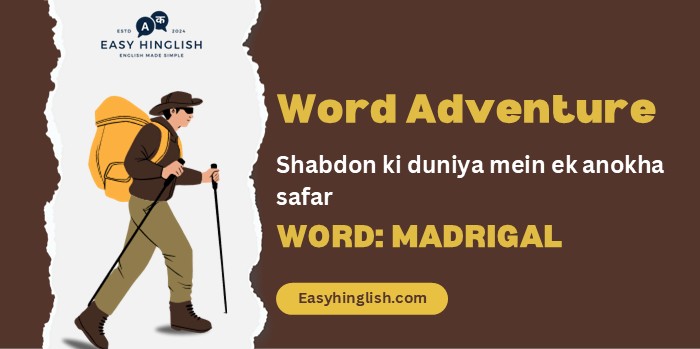Word Adventure: Madrigal
The Headline
“Madrigal: Jahan Poetry Aur Music Embrace Karte Hain Perfect Harmony Mein”
The Scoop
Language ke grand concert hall mein, kuch words resonate karte hain with special vibrancy jo transcends their dictionary definition. ‘Madrigal’ ek aisa word hai – ek term jo carries within it echoes of Renaissance courts, intimacy of chamber music, aur expressive power of poetic verse. Let’s embark on journey through time to explore this word jo has been setting hearts aflutter for centuries.
Let’s Break It Down
The Plot Thickens
Madrigal ki journey begins karti hai 14th-century Italy mein, jahan ye first emerge hua as simple, pastoral poem. 16th century tak, ye evolve ho gaya tha into sophisticated musical form jo captured the hearts of Renaissance Europe, particularly flourishing in Italy aur England.
Jo cheez makes madrigal fascinating ye hai iska dedication to expressing emotion aur imagery of its text. Unlike sacred music of the time, madrigals embrace karte the secular themes – love, nature, aur pastoral life – with composers crafting intricate musical phrases to highlight specific words aur sentiments. Ye “word painting” technique made madrigals revolutionary, as jab text mention karta tha “ascending to heaven,” melody literally rise up karti thi scale par.
English madrigal school, led by composers like Thomas Morley aur John Dowland, adapted the Italian style with distinctive English flair. Ye compositions often perform hote the in intimate settings among friends aur family – Renaissance equivalent of social gathering around piano. Madrigal ki ability to blend sophisticated musical techniques with accessible, emotional themes made it popular music of its day.
Word in the Wild
The Twist
Yahan hai fascinating aspect of madrigals jo many don’t realize: ye the among first truly democratic musical forms. Unlike much earlier music jo compose kiya jaata tha for church ya court, madrigals publish hote the in part-books for amateur musicians to perform at home. Ye early form of “sheet music for masses” help kiya spread musical literacy beyond professional musicians. In essence, madrigals the Renaissance equivalent of popular songs jo friends might gather to sing together – making them not just art form but social activity jo strengthened community bonds. Ye democratization of music would later influence everything from parlor songs to modern-day karaoke!
Make It Stick
Madrigal: Jahan poetry finds its melody aur music finds its meaning!
Your Turn
Kya aapne ever experience kiya hai piece of music jo perfectly captured the emotions of its lyrics? Perhaps ek song jahan melody rises aur falls with meaning of words? That’s the essence of madrigal tradition living on! Share kijiye apna experience of “word painting” in music comments mein below. Ya, agar aap feeling adventurous, try crafting short madrigal-style poem about something jo moved you recently. Let’s explore karte hain how ye Renaissance tradition still influences humara appreciation of interplay between words aur music!
Down the Rabbit Hole
- Curious about hearing madrigals performed? Look up recordings by ensembles like The King’s Singers, The Tallis Scholars, ya La Venexiana.
- Interested in other musical-poetic forms? Explore kijiye world of lieder, art songs, ya modern concept of song cycle.
- Want to delve into Renaissance culture jo produced madrigals? Research kijiye concept of “sprezzatura,” role of music in humanist education, ya Medici family’s patronage of arts.
The Last Word
Jaise hum conclude kar rahe hain humara harmonic exploration of ‘madrigal’, main hope karta hun ki aapne gain kiya hai appreciation for is word jo bridges multiple art forms aur centuries of human expression. Madrigal remind karta hai humein ki some of our most profound experiences occur at intersection of different forms of creativity. Next time jab aap find karenge yourself moved by song jo perfectly marries lyrics aur melody, remember kijiye ki aap experience kar rahe hain living legacy of madrigal tradition! Until our next word adventure, ye hai Prashant from Wordpandit, encouraging you to find the music in language aur poetry in every day!








